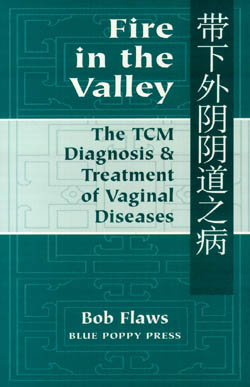Acupuncture and TCM Books
Fire in the Valley:
The Traditional Chinese Medical Diagnosis and Treatment of Vaginal Diseases
by Bob Flaws
DESCRIPTION: This book is a collection of translations from classical and modern Chinese sources on the diagnosis and treatment of diseases of the vagina, cervix, and external genitalia. Herbal and acupuncture protocols are given for vaginitis, cervicitis, cervical erosion, herpes genitalia, vaginal itch, yeast infections, venereal warts, abnormal vaginal discharge, bartholinitis, Naboth´s cyst, and more.
Preface to the Second Edition
Dai xia is usually translated as abnormal vaginal discharge or leukorrhea. Dai means belt or girdle and refers to the dai mai or belt vessel. Xia means down or below. Traditionally, Chinese doctors specializing in gynecology were often called dai xia yi or dai xia doctors and dai xia ke or specialty in dai xia was a synonym for gynecology or problems below the belt. To this day, if one asks what constitutes traditional Chinese fu ke or gynecology, the answer is jing dai chan hou or menstrual complaints, dai xia, and pre and postpartum conditions. Zhang Zhong-qing's Jin Gui Yao Lue (Essentials from the Golden Cabinet) is the first Chinese medical classic to contain a chapter specifically devoted to gynecology. In that
chapter, Zhang says,
The 36 diseases that derive from vacuity and replete cold of the dai mai have a thousand variations. Therefore, it is necessary to carefully discriminate between yin and yang, vacuity and repletion, and tight bowstring [pulses] before applying acupuncture and medicinals in order to secure and save patients who may have the same disease but different pulses due to different causes. This rule must be remembered and should not be regarded with indifference.
As the above passage suggests, there are numerous varieties of female complaints associated with the dai mai. As a practitioner specializing in Chinese gynecology, I have spent considerable time going through the Chinese literature regarding dai xia and other related gynecological complaints. Although the English language literature on menstrual disorders is relatively complete, I feel that it is clinically incomplete regarding abnormal vaginal discharge, vaginitis, vulvitis, cervicitis, and vaginal itching. These are commonly encountered problems in clinical practice. Therefore, I would like to share my literary research on these problems with my fellow English-speaking practitioners.
This is the first series of translations from the Chinese medical literature which I have undertaken essentially on my own. However, they could never have been completed without the support and assistance of my old friend Zhang Ting-liang who helped me find the characters I otherwise could not and clarified a number of colloquial expressions. These translations have been taken from a number of Chinese sources. These have been listed in the bibliography at the back of this book and the sources identified by title and author in the body of the text. Thanks are due to my Chinese herb teacher, Dr. Yu Min of the Yue Yang Hospital, Shanghai, for supplying me with a number of these books, especially those published in the last 2-3 years.
In preparing this revised edition, I have made the following changes in the text: 1) I tried, as far as possible, to use the terminology suggested by Nigel Wiseman in his English-Chinese Chinese-English Dictionary of Chinese Medicine, Changsha, 1995. I fully endorse Mr. Wiseman's arguments for and attempts to standardize our profession's technical terminology. For an iron-bound argument why such a linguistically accurate standard translational terminology is necessary within the English-speaking profession, please see Wiseman´s essay on this subject at Paradigm Publications web page, www.paradigm-pubs.com. 2) I have added Pinyin in parentheses for all Chinese medicinals. 3) I have added English language translations for all Chinese medicinal formulas. 4) I have deleted some material which I feel had become dated and no longer expressed my point of view. And 5) I repaired some of the English which, in my attempts to remain as close to the Chinese as possible, was often stilted. Hopefully, these changes will make this book easier and more pleasant to use.
 Fire in the Valley:
Fire in the Valley: